Table of Contents
Step into a world where time bends and history unfolds through a captivating visual journey. In this compelling exploration, we traverse the past and present, juxtaposing iconic historical locations in their former glory with their contemporary counterparts.
These then and now pictures bear witness to the passage of time, the indomitable spirit of resilience, and the evolving tapestry of human civilization. With every photograph, you’ll discover the profound stories hidden within these remarkable places, each frame a testament to the enduring legacy of our shared heritage.
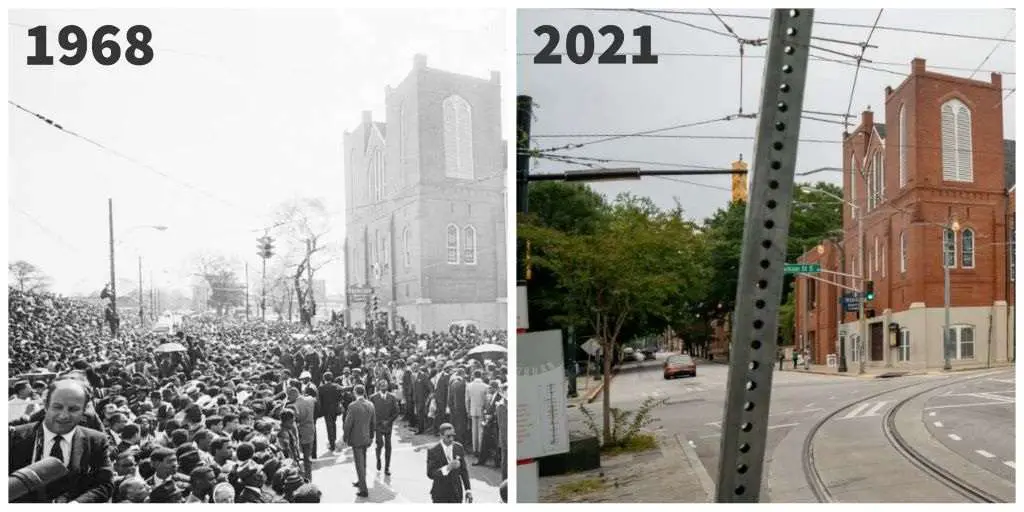
Ebenezer Baptist Church’s Revered Legacy in Atlanta, 1968 and 2021
This narrative unveils the enduring legacy of Atlanta’s Ebenezer Baptist Church through images captured in 1968 and 2021. On April 9, 1968, the church bore witness to a profound gathering of mourners paying their heartfelt tributes to Dr. Martin Luther King, Jr.
The civil rights icon and Nobel Peace Prize laureate had tragically fallen victim to an assassin’s bullet just five days earlier. His death sent shockwaves across the nation, leaving behind a legacy of peaceful activism and a fervent pursuit of racial equality. It was within the hallowed halls of Ebenezer Baptist Church that Dr. King had delivered his poignant eulogy, recorded during his final sermon at the church.
In that eulogy, he implored that he be remembered not for his awards or honors but for his tireless efforts to alleviate hunger, advocate for peace during the Vietnam War, and, above all, to “love and serve humanity.” The 1968 image captures the commencement of his funeral procession, marking a poignant moment in history. Today, Ebenezer Baptist Church stands as a symbol of Dr. King’s enduring work and continues to champion a ministry founded on principles of social justice.
Ebenezer Baptist Church, steeped in historical significance, was the solemn backdrop on that fateful day in 1968 when Dr. Martin Luther King, Jr. lay in repose. The church’s pews were filled with mourners from all walks of life, each paying their heartfelt respects to the fallen civil rights leader.
Dr. King’s eulogy, conveyed through a recording of his final sermon at Ebenezer Baptist Church, held a poignant message. In his own words, he emphasized that his legacy should not be built upon accolades or honors but upon his commitment to feed the hungry, advocate for peace in the midst of the Vietnam War’s turbulence, and wholeheartedly “love and serve humanity.”
The 1968 image, captured as Dr. King’s funeral procession commenced, reflects a moment in history that transcends time. In the subsequent decades, Ebenezer Baptist Church has continued to stand as a symbol of Dr. King’s indomitable spirit and unwavering dedication to justice.
Today, it carries forward a ministry deeply rooted in social justice, echoing the principles and ideals championed by Dr. King. As it remains a beacon of hope and a testament to a transformative legacy, Ebenezer Baptist Church inspires generations with the enduring message that love, service, and the pursuit of justice can shape a more equitable world.
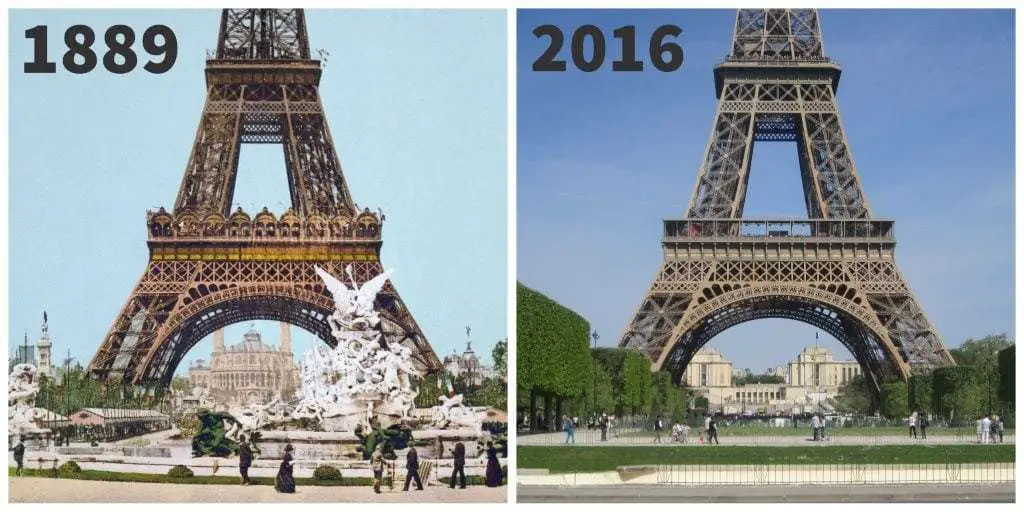
Eiffel Tower’s Evolution in Paris, 1889 and 2016
This narrative invites you to explore the majestic journey of the Eiffel Tower, a symbol of Paris, France, through images captured in 1889 and 2016. Few structures on Earth rival the iconic status of this towering masterpiece. When it made its debut at the 1889 Paris World’s Fair, it astoundingly recouped the cost of its construction within just one year, primarily through ticket sales.
Critics of the era may have derided it as an extravagant eyesore, but little did they know that the Eiffel Tower would ignite the imagination of future World’s Fair designers, setting an enduring standard for innovative and captivating architectural design.
Originally slated for dismantling in 1910, the visionary Gustave Eiffel repurposed it as a radio tower, scientific laboratory, and even a semi-secret apartment space, thus ensuring its practicality and saving it from oblivion. The Eiffel Tower stands today as a global tourist icon, having welcomed over 167 million visitors since its inauguration in 1889.
The Eiffel Tower, an unparalleled symbol of grandeur, made its unforgettable debut at the 1889 Paris World’s Fair. Its remarkable achievement lay not just in its architectural splendor but in its ability to swiftly recover its construction costs through ticket sales within a mere year.
Ironically, contemporaneous critics dismissed it as an opulent eyesore. However, the Eiffel Tower’s profound impact reverberated through time, serving as an inspiration for future World’s Fair designers who aspired to “out-Eiffel Eiffel,” setting new benchmarks for visionary and captivating design.
In a pivotal turn of fate, Gustave Eiffel, the visionary behind the tower’s creation, thwarted its scheduled dismantling in 1910. With foresight, he transformed it into a multi-purpose marvel, repurposing it as a radio tower, scientific laboratory, and even an enclave of semi-secret apartments.
This ingenious adaptation endowed the Eiffel Tower with practical functions, ultimately preserving its legacy and ensuring its status as a global tourist attraction, as vividly captured in the modern image. Since its unveiling in 1889, this iconic structure has played host to over 167 million visitors, standing as a testament to the enduring power of architectural marvels to captivate and inspire across generations.
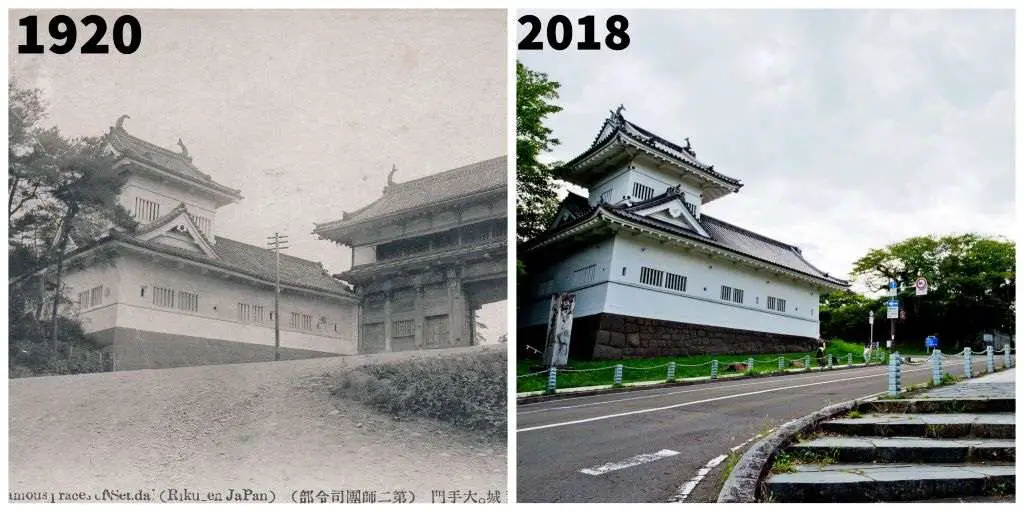
Evolution of the Former Japanese Imperial Army 2nd Division, 1920 and 2018
This narrative delves into the compelling journey of the Former Japanese Imperial Army 2nd Division through images captured in 1920 and 2018. Nestled in the heart of Sendai, Japan, the Second Division found its headquarters within the storied confines of Aoba Castle, now located on the campus of Tohoku University. Aoba Castle, an architectural gem from the Edo period (1607-1863), rose during an era marked by stability under the bakuhan government system.
Here, the Second Division shared its headquarters with the 4th, 5th, 16th, 17th, and later the 29th Infantry Regiments. The 1920 image, captured in the interlude between the Russo-Japanese War (1904-1905) and conflicts with the Soviet Union (commencing in 1932), showcases the Wakiyagura of Aoba Castle and the Ōtemon Gate.
Yet, the passage of time and the tumultuous events of World War II witnessed the devastation of these historic edifices in July 1945, at the hands of United States forces. While the reconstructed Wakiyagura tower drew tourists back to the site, the modern image reveals the poignant absence of the Ōtemon Gate from the restoration.
The Second Division’s legacy unfolds within the walls of Aoba Castle, a captivating relic from the Edo period that bore witness to an era marked by stability under the bakuhan government system. On this hallowed ground, the Second Division coexisted with the 4th, 5th, 16th, 17th, and later the 29th Infantry Regiments, all sharing the castle’s historic halls.
The 1920 image, captured during a pivotal juncture between the Russo-Japanese War and looming conflicts with the Soviet Union, offers a glimpse of the resplendent Wakiyagura of Aoba Castle and the formidable Ōtemon Gate.
The echoes of history took a poignant turn in July 1945, when the reverberations of World War II culminated in the destruction of both the Wakiyagura tower and the Ōtemon Gate at Aoba Castle, orchestrated by United States forces. A chapter of devastation unfolded, casting shadows over these once-majestic edifices.
However, in the post-war era, a phoenix of renewal emerged as the reconstructed Wakiyagura tower beckoned tourists to revisit the site, kindling renewed interest in its history. Yet, the modern image, marked by the absence of the Ōtemon Gate, offers a somber reminder of the enduring scars of conflict and the delicate balance between restoration and preservation.
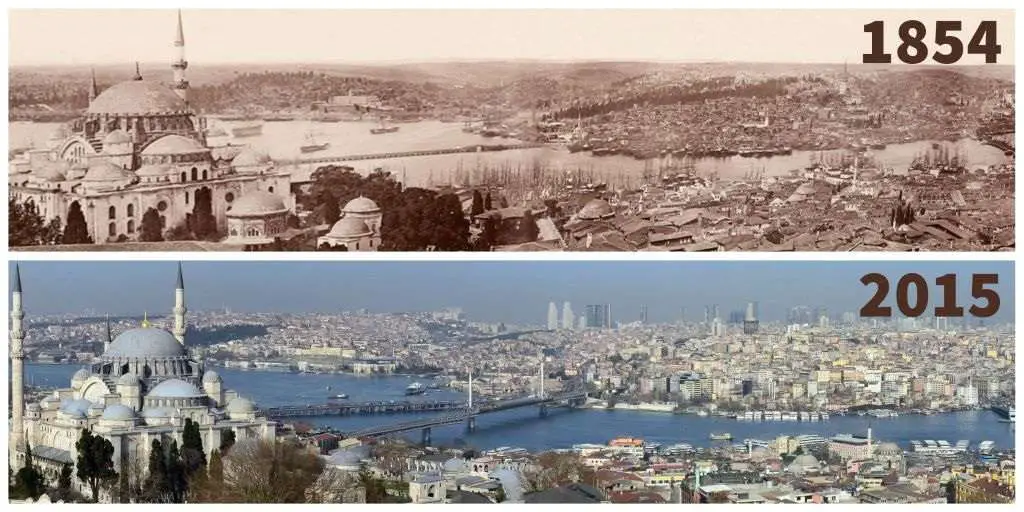
Haliç – The Golden Horn’s Evolution in Istanbul, 1854 and 2015
This narrative embarks on a captivating journey through time, capturing the transformation of Haliç, known as the Golden Horn, in Istanbul, Turkey, through images from 1854 and 2015. In 1854, the Golden Horn was a coveted port location, revered for its unique absence of tides and currents.
It burgeoned into a hub of trade, governance, and served as the headquarters of the Byzantine navy. However, its prosperity also rendered it vulnerable to external threats. To safeguard this prized port, the city erected the traditional city wall, augmented by an ingenious security measure: a colossal iron chain spanning the waterway, effectively blocking passage for ships.
The 1854 image encapsulates the river’s flow past the imposing Blue Mosque, a prominent historic edifice that once presided over Haliç. Today, this region has blossomed into a vibrant tourist district, adorned with historic mosques, bustling bazaars, charming shops, and inviting restaurants.
The images together bear witness to the remarkable growth and expansion of Haliç, where skyscrapers now stand where countryside once sprawled, yet the resplendent Blue Mosque continues to cast its majestic shadow, weaving the city’s past into its dynamic present.
The Golden Horn, in 1854, held a preeminent position as a prime port location, celebrated for its unique characteristic of being free from the influences of tides and currents. This remarkable quality propelled it to become a focal point of trade, a center of governance, and the esteemed headquarters of the Byzantine navy.
However, its burgeoning wealth and strategic significance also made it susceptible to potential attacks. In response, the city fortified its defenses with the traditional city wall, bolstered by a distinctive security innovation: an immense iron chain that spanned the width of the waterway, serving as an impervious barrier to ship passage. The 1854 image evokes the serene flow of the river past the commanding presence of the Blue Mosque, an iconic symbol of the era.
Today, the Golden Horn’s landscape has undergone a profound metamorphosis, blossoming into a vibrant tourist district that teems with the echoes of history. Historic mosques, bustling bazaars, captivating shops, and inviting restaurants have transformed the area into a thriving hub of culture and commerce.
The images from 1854 and 2015 stand as a testament to the region’s evolution, with modern skyscrapers now gracing spaces once inhabited by countryside. Yet, amidst this vibrant transformation, the timeless silhouette of the Blue Mosque continues to cast its majestic shadow over the city, forging an unbreakable link between Istanbul’s past and its dynamic present.
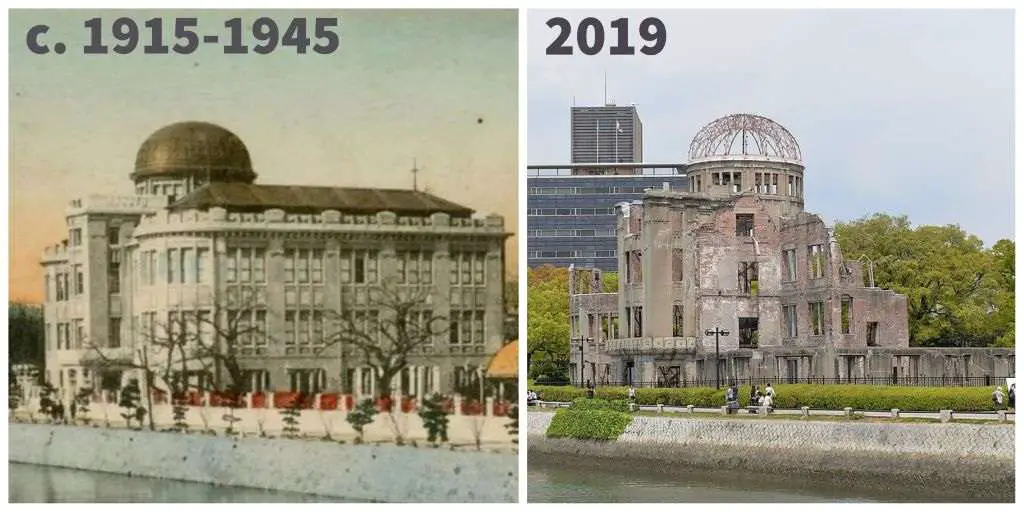
Genbaku Dome – A Symbol of Hope and Peace in Hiroshima, Then and Now
This narrative embarks on a poignant journey through history, capturing the enduring spirit of the Genbaku Dome, also known as the Peace Dome, in Hiroshima, Japan. On August 6, 1945, a moment that would change the course of history, the United States deployed the world’s first atomic bomb on the city of Hiroshima.
Amidst the devastation that followed, the Genbaku Dome emerged as the sole structure in the epicenter area to withstand the cataclysmic blast. A silent sentinel, this building, originally constructed in 1915 as the Hiroshima Prefectural Products Display Hall, served as a bustling marketplace for locally crafted goods, showcasing the city’s rich heritage and surrounding prefectures.
Its striking copper dome and robust brick-and-steel architecture stood in stark contrast to the predominantly wooden cityscape. When the atomic bomb detonated nearly directly above the dome, it claimed the lives of all within. However, the indomitable earthquake-resistant columns that anchored the structure held firm against the devastating forces of the blast.
Today, the preserved remnants of the Genbaku Dome stand as a powerful memorial, an unwavering plea for peace, and a fervent aspiration that the specter of nuclear weapons will never again darken humanity’s path.
August 6, 1945, etched an indelible mark in history when the United States deployed the world’s first atomic bomb upon Hiroshima. Amid the relentless devastation that followed, a singular structure in the epicenter area emerged as a beacon of resilience—the Genbaku Dome.
Initially, this historic edifice was born in 1915 as the Hiroshima Prefectural Products Display Hall, serving as a bustling marketplace for locally produced treasures that celebrated the city’s rich cultural heritage and that of the neighboring prefectures. Distinguished by its distinctive copper dome and robust brick-and-steel construction, the hall stood as a testament to architectural excellence in a city predominantly built of wood.
When the atomic bomb’s cataclysmic detonation occurred, almost directly above the dome, it claimed the lives of all who were sheltered within its walls. Nevertheless, a testament to human ingenuity and resilience emerged from the ashes. The Genbaku Dome’s earthquake-resistant columns, designed to withstand the tremors of nature, valiantly bore the downward forces of the blast.
Today, these preserved remnants stand as an enduring memorial—a powerful voice advocating for peace and a stark reminder of the horrors of nuclear warfare. The Genbaku Dome’s presence continues to echo throughout history, a poignant plea that the world may never again bear witness to the devastating use of nuclear weapons.
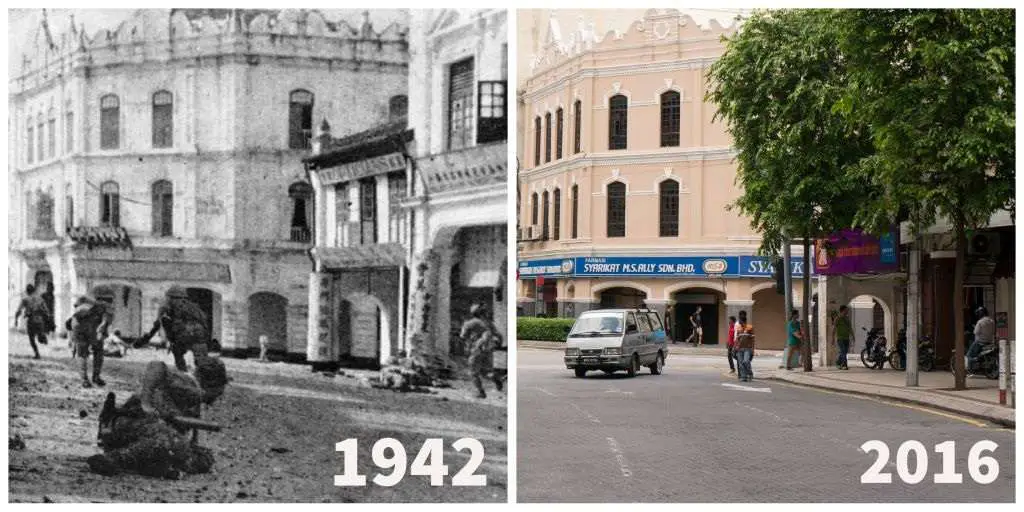
Japanese Troops in Kuala Lumpur, 1942 and 2016
This narrative embarks on a compelling journey through time, capturing the evocative story of Japanese troops advancing through Kuala Lumpur in 1942 and a poignant glimpse of the city in 2016. In December 1941, against the backdrop of World War II, Japan embarked on a bold invasion of British-held colonies, including the resource-rich land of Malaya, known today as Malaysia.
Malaya was endowed with abundant rubber and tin resources, precious commodities that the British exported to support their allies’ war efforts, and that Japan sought to control. Strategically positioned, Malaya, including the bustling city of Kuala Lumpur, held immense significance in Japan’s plans to expand its territorial boundaries and secure crucial oil resources.
The Japanese offensive proved resoundingly successful, as British authorities had underestimated Japan’s capacity to conquer the region. Consequently, officials hastily abandoned Kuala Lumpur, leaving it vulnerable to Japanese occupation. The 1942 image encapsulates a somber chapter in history as Japanese forces meticulously quelled resistance cells within the city.
Iconic landmarks such as the train station, government offices, and Pudu Jail fell under Japanese control. Pudu Jail, notorious for its role as a POW detention center, bore witness to inhumane conditions, rampant disease, and acute food shortages. Kuala Lumpur remained under Japanese occupation until September 1945 when it was returned to British rule.
The stage was set in December 1941 when Japan launched an audacious invasion of British-held colonies, driven by a fervent desire to secure crucial resources, including rubber and tin, that were of paramount importance to their war efforts. Malaya, a veritable treasure trove of these valuable resources, was in Japan’s crosshairs.
Within Malaya’s heart lay Kuala Lumpur, a city that had unwittingly become a pivotal theater in Japan’s territorial ambitions. The city’s strategic location and abundant resources made it a linchpin in Japan’s quest for expansion. British authorities, however, underestimated Japan’s resolve and capabilities, leading to a hasty abandonment of Kuala Lumpur in the face of the advancing Japanese forces.
The 1942 image captures a poignant tableau of Japanese forces meticulously consolidating their control over Kuala Lumpur, suppressing any vestiges of resistance that dared to persist. Iconic landmarks such as the train station, government offices, and the infamous Pudu Jail stood as testaments to Japanese authority.
Pudu Jail, a grim symbol of oppression, doubled as a POW detention center, where incarcerated souls endured the torment of disease, starvation, and squalor. The Japanese occupation of Kuala Lumpur endured until September 1945 when the city was liberated from their grasp and returned to British rule. The echoes of this tumultuous past continue to reverberate through history, reminding us of the indomitable human spirit that perseveres even in the darkest of times.
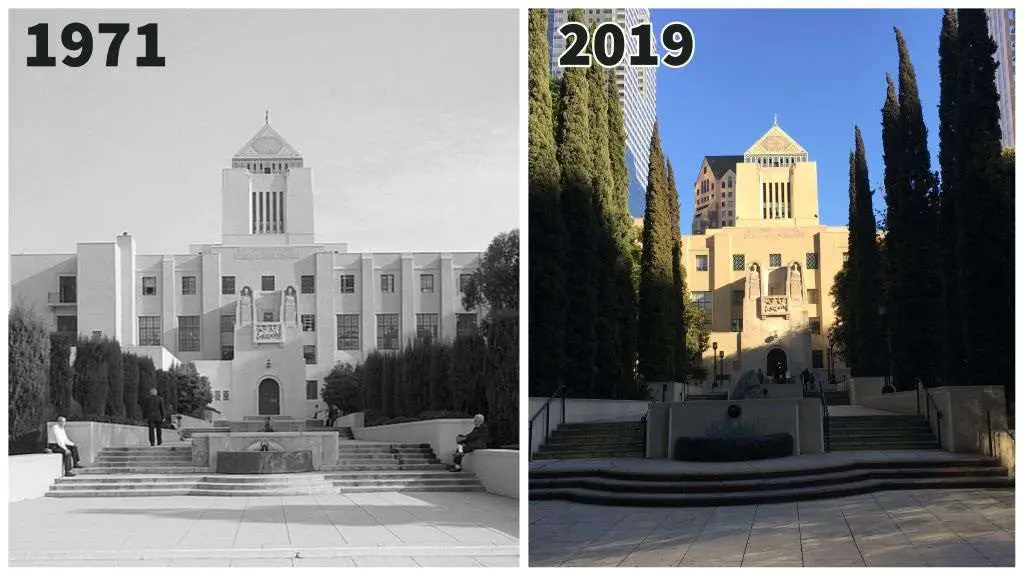
Timeless Transformation: Los Angeles Public Library, 1971 and 2019
This narrative embarks on a captivating journey through time, unraveling the architectural evolution of the Los Angeles Public Library, as depicted in images from 1971 and 2019. In the early 1920s, the library was poised to establish its presence on the site of the former State Normal School lot, a mere block away from the picturesque Pershing Square.
The Library Board’s visionary decision to enlist the services of architect Bertrand Goodhue in the mid-1920s was underscored by the hope that he would employ the enchanting Spanish Colonial style he had so masterfully showcased at the 1915 Panama California Exposition.
However, Goodhue’s creative compass had veered toward modernism, and he embraced a resplendent Art Deco aesthetic instead. The 1971 image offers a captivating view of the library’s grand facade, welcoming visitors from Flower Street and guiding them through the lush Maguire Gardens—a tribute to real estate developer Robert Maguire, whose efforts in the wake of a devastating 1986 arson incident helped restore the library and its verdant surroundings.
In the modern image, nature’s embrace, symbolized by the verdant trees that create a serene vista, partially conceals the building while extending a compelling visual invitation to the library’s entrance.
The early 1920s marked a transformative period for the Los Angeles Public Library, as it embarked on a mission to establish its new home upon the hallowed grounds of the former State Normal School lot, nestled just a stone’s throw away from the enchanting Pershing Square.
The Library Board’s ambitious vision crystallized when they engaged the services of acclaimed architect Bertrand Goodhue in the mid-1920s. Their aspiration was for Goodhue to channel the captivating Spanish Colonial style that had garnered acclaim at the 1915 Panama California Exposition. However, Goodhue’s artistic trajectory had taken a modern turn, and he chose to craft a grand Art Deco masterpiece instead.
The 1971 image serves as a window to the past, offering a glimpse of the library’s magnificent facade. This architectural marvel, which beckons visitors from Flower Street, is complemented by the enchanting Maguire Gardens—an idyllic oasis that bears the name of the dedicated real estate developer Robert Maguire.
Maguire played an instrumental role in the library’s restoration, following a devastating arson incident in 1986. In the modern image, the verdant trees that grace the surroundings create a natural vista that conceals a portion of the building. Yet, they also extend a compelling visual cue, inviting all to traverse their welcoming embrace and discover the treasure trove of knowledge that lies within the library’s walls.
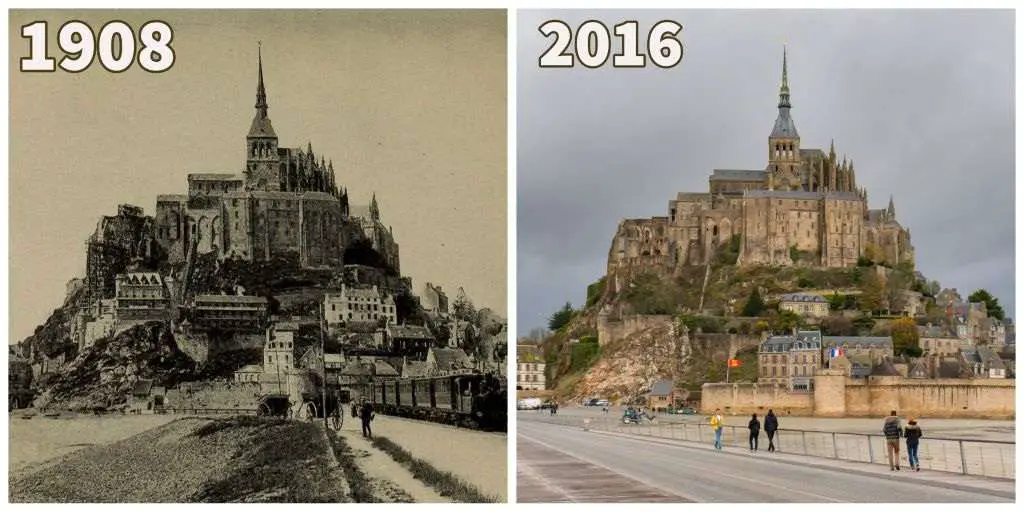
Mont Saint-Michel’s Journey, 1908 and 2016
This narrative embarks on a mystical journey through time, unveiling the timeless legend of Mont Saint-Michel, as depicted in images from 1908 and 2016. The legend’s inception dates back to a celestial dream in 708 CE, when the Bishop of Avranches, later revered as Saint Aubert, experienced a divine visitation by Archangel Michael.
In this ethereal encounter, the angel beseeched the bishop to construct a sanctuary in his honor. This otherworldly vision seamlessly transitioned into reality, as, by 966 CE, Benedictine monks had established a resplendent abbey atop a solitary hill. Here, they extended a warm welcome to pilgrims and travelers, though the challenge lay in the ever-shifting tides that intermittently isolated the hill from the mainland, rendering it an inaccessible island twice a day at high tide.
Since 1928, contemporary constructions fashioned to replicate historic designs have gradually succumbed to the relentless passage of time. To safeguard the village’s original historic ambiance, a concerted effort has been undertaken to remove these newer structures, thus preserving the sacred atmosphere of Mont Saint-Michel. Additional endeavors are currently underway to preserve the delicate waterways that surround this mystical site.
The legend of Mont Saint-Michel originates in the mists of time, anchored by a celestial dream that transpired in 708 CE. It was during this mystical encounter that the Bishop of Avranches, later canonized as Saint Aubert, received a divine visitation from Archangel Michael himself. In this ethereal communion, the angel fervently implored the bishop to undertake the sacred task of erecting a sanctuary in his honor.
This spiritual vision gracefully transitioned into reality, culminating in the establishment of a resplendent abbey perched atop a solitary hill. By 966 CE, Benedictine monks had made this spiritual haven their home, extending a warm and gracious welcome to pilgrims and wayfarers. Yet, the whims of nature posed a formidable challenge, as the ever-changing tides would, twice daily, cut off the hill from the mainland, transforming it into an isolated island.
The 1908 image evokes a bygone era, offering a glimpse into the timeless allure of Mont Saint-Michel. Over time, contemporary structures constructed to replicate historic designs began to gracefully surrender to the relentless march of time. Recognizing the irreplaceable value of the village’s original historic aura, a dedicated initiative emerged to carefully remove these newer additions.
This resolute commitment ensures the preservation of Mont Saint-Michel’s sacred atmosphere. Furthermore, ongoing efforts are steadfastly aimed at conserving the fragile waterways that grace this mystical site, safeguarding its enduring legacy for generations to come.
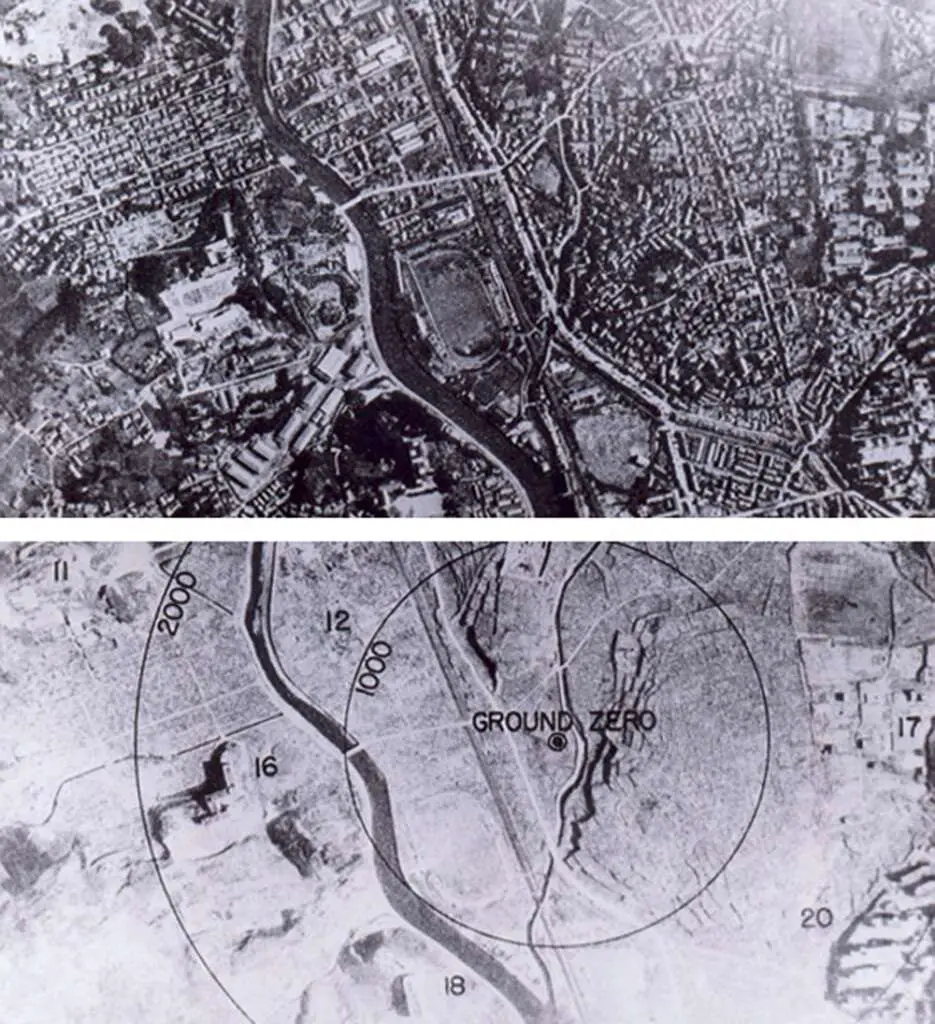
Nagasaki’s Heartbreaking Transformation: Pre-1945 and Post-August 9, 1945
This narrative delves into the heart-wrenching transformation of Nagasaki’s urban landscape, a metamorphosis that unfolded in the blink of an eye. The top image paints a vivid portrait of a densely woven urban community, its streets weaving through various zones of development while a tranquil river meanders through the cityscape.
However, this serenity was abruptly shattered when history took a devastating turn. Mere days after the catastrophic bombing of Hiroshima, the United States readied itself for a second fateful strike, with the city of Kokura initially earmarked as the target. Yet, fortune and nature intervened.
Kokura lay concealed beneath an impenetrable shroud of cloud cover, thwarting the U.S. forces’ attempts to secure a clear visual on their intended target. Consequently, Nagasaki, a city thrust into an unintended role, bore the brunt of the nuclear onslaught. The bomb’s cataclysmic impact claimed the lives of approximately 80,000 people, with countless more succumbing to the insidious effects of radiation in the aftermath.
The devastation radiated outward for a mile, its horrific reach marked by relentless fires that consumed everything in their path. In stark contrast to Hiroshima, where the iconic dome and other modern structures still stand, Nagasaki’s architectural fabric was predominantly composed of traditional wooden frames, even in its industrial and commercial edifices. Tragically, none of these structures survived the cataclysmic blast.
The imagery from the top picture paints a poignant picture of Nagasaki’s urban tapestry, a tightly interwoven community that thrived against the backdrop of a tranquil river coursing through the city streets. However, this serene facade was destined to be irrevocably shattered by a seismic event in history.
A mere three days following the cataclysmic bombing of Hiroshima, the United States embarked on a fateful mission, initially setting its sights on Kokura as the next target. Yet, an unpredictable twist of fate intervened in the form of nature’s veil. Kokura was concealed beneath an impenetrable blanket of cloud cover, frustrating the United States forces’ quest for a clear visual confirmation of their intended target. In an unforeseen turn of events, Nagasaki was thrust into the heart of an unintended crisis.
The bomb’s harrowing impact on Nagasaki’s landscape was nothing short of catastrophic. The toll it exacted was staggering, with the lives of approximately 80,000 people tragically cut short, while countless others confronted the ominous specter of radiation sickness in the aftermath.
The devastation wrought by this unprecedented event extended its malevolent reach for a mile, leaving a trail of relentless fires that consumed everything in their fiery path.
Unlike Hiroshima, where the iconic dome and other modern structures stand as eerie witnesses to that fateful day, Nagasaki’s architectural makeup predominantly comprised traditional wooden frame structures, even in its industrial and commercial domains. Tragically, not a single one of these structures emerged unscathed from the cataclysmic maelstrom that swept through the city.
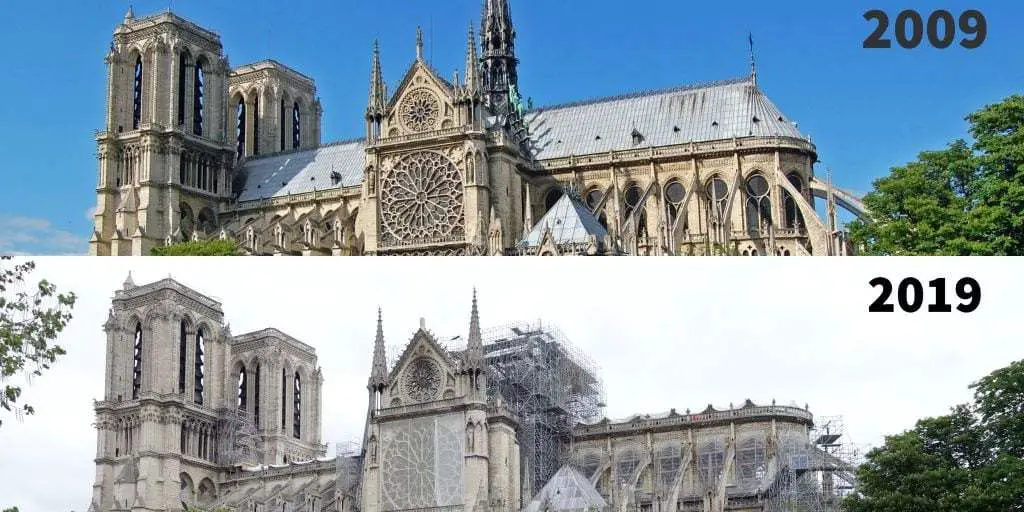
Resilience and Renewal: Notre-Dame, Paris, France, 2009 and 2019
This narrative embarks on a poignant journey through time, unveiling a decade of profound transformation in the iconic backdrop of Notre-Dame, as reflected in images from 2009 and 2019. These photos bear witness to one of the most heart-wrenching blows to the global historical community—the catastrophic fire that ravaged Notre-Dame in 2019.
Remarkably, the cathedral had withstood centuries of trials, including Huguenot attacks, the tempestuous French Revolution, and the ravages of World War II. Yet, it was during a project intended to protect this historic monument that disaster struck. The fire exacted a heavy toll, severely damaging the cathedral’s roof and reducing its soaring spire to ashes.
This spire, however, was not part of the original structure; it had been a mid-1800s replacement. Amidst the devastation, a glimmer of hope emerged as the copper rooster, a cherished symbol of the French people, which had perched atop the spire, was discovered and meticulously preserved.
The fire also claimed the cathedral’s “forest,” the venerable beams that had comprised the attic level. These beams had gallantly weathered eight centuries of history but were now relegated to memory. However, amidst the charred remnants, Notre-Dame’s indomitable spirit endured. The cathedral’s main structure, its historic stained-glass windows, and a multitude of sacred artifacts were miraculously spared from the engulfing flames.
The journey through time begins in 2009, offering a glimpse of Notre-Dame’s resplendent facade before the trials that would reshape its destiny. This cathedral, a cherished testament to the enduring spirit of humanity, had weathered countless storms throughout its storied history.
It bore witness to Huguenot attacks, the tumultuous tempest of the French Revolution, and even the ravages of World War II. However, the most devastating blow was yet to come, lurking amidst a project intended to safeguard this cultural gem.
In the annals of history, the year 2019 will forever be etched as a time of unparalleled tragedy for Notre-Dame. The catastrophic fire that engulfed this iconic cathedral inflicted severe wounds upon its timeless beauty. The cathedral’s roof lay in ruins, and its soaring spire, though a mid-1800s replacement, was reduced to ash.
Amidst the despair, a beacon of hope shone through—the cherished copper rooster that had graced the pinnacle of the spire was discovered and meticulously preserved. The fire also claimed the cathedral’s “forest,” the venerable beams that had adorned the attic level for eight centuries.
These beams, though now relegated to the realm of memory, had borne silent witness to history’s unfolding drama. Yet, amidst the charred remnants, the cathedral’s indomitable spirit endured. The main structure stood tall, its historic stained-glass windows exuding a timeless radiance, and a multitude of sacred artifacts found salvation from the engulfing flames.
You may also read:
- Jackass Annie’s (Annie Wilkins) Remarkable Journey: A Tale of Courage and Survival”
- Who is Aunt Polly Jackson? Freedom Fighter on the Underground Railroad
Conclusion
As we conclude this captivating journey through time and place, these then and now images and narratives leave an indelible mark on our understanding of history’s ever-shifting sands. From the hallowed halls of Notre-Dame to the tranquil beauty of Mont Saint-Michel, the enduring fortitude of Nagasaki, and the poignant rebirth of Notre-Dame, we’ve witnessed the remarkable narratives etched into these iconic locations.
Through the lens of time, we’ve seen destruction and renewal, the fragility of our past, and the resilience of our shared heritage. These stories, bridging past and present, continue to inspire, reminding us of the beauty and strength inherent in our collective history.

